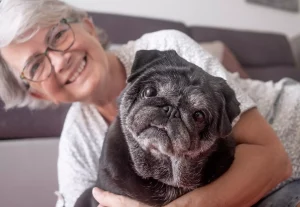 Euthanasia: Before, During, and After
Euthanasia: Before, During, and After
Euthanasia happens when a pet owner makes the hard decision to end their pet’s life to relieve suffering from incurable pain or illness. In veterinary medicine, this choice is often seen as a compassionate act freeing pets from pain and allowing them to cross over the rainbow bridge with dignity.
Choosing euthanasia for your pet can be an extremely difficult decision, but some factors, however, may help with the decision process. Our veterinarian team can offer advice, guidance and support during this time so that you can make the best decision for your pet.
Before the Procedure
We will discuss aftercare options, including home burial or cremation services.
You’ll also have the opportunity to decide whether you’d like to be present during the procedure. This is entirely a personal choice and varies greatly from one pet owner to another. Some feel unable to witness their pet’s passing, while others find comfort in being there during their pet’s final moments. There is no right or wrong choice. The grieving process is different for everyone, and our team fully respects and supports whatever decision feels best for you.
We will also complete the necessary paperwork and collect payment ahead of time to help make the process as smooth and stress-free as possible.
To prepare for the procedure, your pet will be taken to our treatment area for our technician team to place an IV catheter. This allows for a calm and efficient administration of the euthanasia solution. Once the catheter is placed, your pet will be returned to the room to be with you, and when you are ready, our veterinarian will begin the procedure.
What to Expect During Euthanasia
Euthanasia can feel overwhelming, especially if you’re unsure what the expect. Our veterinarian team will walk you through the process beforehand and answer any questions you may have. While difficult to think about, understanding the procedure can help bring comfort and peace of mind.
The Euthanasia Process
In most cases, a sedative is given first to help your pet relax or fall into a deep sleep before the final injection. This is similar to anesthesia and can make the transition even more peaceful.
When you are ready, the euthanasia solution will be administered. The solution is a barbiturate that quickly and painlessly stops both heart and lung function. It is given through the IV catheter, and your pet will gently pass within 30-60 seconds.
Afterward, the veterinarian will listen for a heartbeat to confirm your pet has passed.
What You Might Notice
Each animal responds a little differently, but most pets simply appear to fall into a deep, restful sleep. However, it is important to be aware of the following, all of which are natural and painless responses of the body:
- The eyes may remain open after passing
- A final breath or twitch may occur (muscle reflex, not conscious)
- Occasional vocalization, though not common
- The heart may beat briefly after breathing stops
- The bladder or bowels may release
These signs can be difficult to witness, but they are normal physical responses of the body and are not signs of pain or distress.
Grief
Remember, healing is a personal journey that doesn’t follow a linear path; be patient with the process, give yourself grace, and allow yourself to grieve at your own pace.
